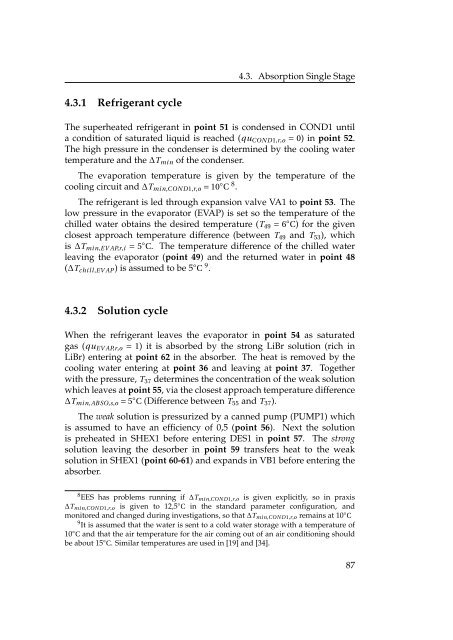integration of solid oxide fuel cells and ... - Ea Energianalyse
integration of solid oxide fuel cells and ... - Ea Energianalyse
integration of solid oxide fuel cells and ... - Ea Energianalyse
You also want an ePaper? Increase the reach of your titles
YUMPU automatically turns print PDFs into web optimized ePapers that Google loves.
4.3. Absorption Single Stage<br />
4.3.1 Refrigerant cycle<br />
The superheated refrigerant in point 51 is condensed in COND1 until<br />
a condition <strong>of</strong> saturated liquid is reached (qu COND1,r,o = 0) in point 52.<br />
The high pressure in the condenser is determined by the cooling water<br />
temperature <strong>and</strong> the ∆T min <strong>of</strong> the condenser.<br />
The evaporation temperature is given by the temperature <strong>of</strong> the<br />
cooling circuit <strong>and</strong> ∆T min,COND1,r,o = 10 ◦ C 8 .<br />
The refrigerant is led through expansion valve VA1 to point 53. The<br />
low pressure in the evaporator (EVAP) is set so the temperature <strong>of</strong> the<br />
chilled water obtains the desired temperature (T 49 = 6 ◦ C) for the given<br />
closest approach temperature difference (between T 49 <strong>and</strong> T 53 ), which<br />
is ∆T min,EV AP,r,i = 5 ◦ C. The temperature difference <strong>of</strong> the chilled water<br />
leaving the evaporator (point 49) <strong>and</strong> the returned water in point 48<br />
(∆T chill,EV AP ) is assumed to be 5 ◦ C 9 .<br />
4.3.2 Solution cycle<br />
When the refrigerant leaves the evaporator in point 54 as saturated<br />
gas (qu EV AP,r,o = 1) it is absorbed by the strong LiBr solution (rich in<br />
LiBr) entering at point 62 in the absorber. The heat is removed by the<br />
cooling water entering at point 36 <strong>and</strong> leaving at point 37. Together<br />
with the pressure, T 37 determines the concentration <strong>of</strong> the weak solution<br />
which leaves at point 55, via the closest approach temperature difference<br />
∆T min,ABSO,s,o = 5 ◦ C (Difference between T 55 <strong>and</strong> T 37 ).<br />
The weak solution is pressurized by a canned pump (PUMP1) which<br />
is assumed to have an efficiency <strong>of</strong> 0,5 (point 56). Next the solution<br />
is preheated in SHEX1 before entering DES1 in point 57. The strong<br />
solution leaving the desorber in point 59 transfers heat to the weak<br />
solution in SHEX1 (point 60-61) <strong>and</strong> exp<strong>and</strong>s in VB1 before entering the<br />
absorber.<br />
8 EES has problems running if ∆T min,COND1,r,o is given explicitly, so in praxis<br />
∆T min,COND1,r,o is given to 12,5 ◦ C in the st<strong>and</strong>ard parameter configuration, <strong>and</strong><br />
monitored <strong>and</strong> changed during investigations, so that ∆T min,COND1,r,o remains at 10 ◦ C<br />
9 It is assumed that the water is sent to a cold water storage with a temperature <strong>of</strong><br />
10 ◦ C <strong>and</strong> that the air temperature for the air coming out <strong>of</strong> an air conditioning should<br />
be about 15 ◦ C. Similar temperatures are used in [19] <strong>and</strong> [34].<br />
87
















